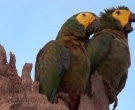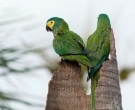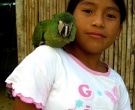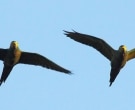Content |
|---|
Description:
50 to 51 cm.. length and a weight between 292 and 390 g.
The Red-bellied Macaw (Orthopsittaca manilatus) is a medium-sized Macaw; has the forecrown and crown a bright blue, gradually faded to blue-green color in the area of the nape and on both sides of the neck. The the mantle and scapulars are green grass with impregnations color olive and yellow edges, producing, altogether, a flaky effect; the back and rump are green grass, with some feathers tipped pale bluish. The uppertail-coverts grass-green. The lesser and median coverts green grass impregnated with green olive with yellowish margins; alula and primary coverts green with vane outer blue; large inner coverts green.
The flight feather bordered with blue and green tips. Under, the wings with coverts yellowish-green and flight feather yellowish. The feathers of the throat and top of the chest are pale grey blue in the Center and yellowish-green in the margins; those of the lower area of the chest and top of the belly without tones pale in the Center, but with some feathers with margins off dark red; belly dark red; undertail-coverts bluish green. Upper, the tail green color in the Center with yellowish margins; upor down yellow.
Bill black; nude part of lores and cheeks yellowish white; irises dark brown; legs dark gray.
Sexes similar, the males, possibly, bigger.
Immature clear tip in the bill and smaller patch of dark red color of the belly.
- Sound of the Red-bellied Macaw.
Habitat:
Lives in Savanna and flooded forest, where there are Palm trees, in altitudes close to the 500 m. Very dependent from the Palma de moriche or aguaje (Mauritia flexuosa), which feeds, staying almost invisible due to its Green plumage.
Occasionally wander in by cultivated areas and have been in the mangroves.
gregarious, flocks of more of 100 observed birds. Usually, they rest in the branches of the Mauritia Palms, where they remain hidden among the foliage of leaves.
Reproduction:
They nest in holes of las palmas dead found near or surrounded by water, often use the nests of the Orange-winged Parrot (Amazona amazonica), of Trinidad and Tobago.
The breeding season is from February to September in Trinidad and Tobago; from February to may in Colombia; from February to June in Guyana. The size of the put is of 2 to 6 eggs with a period of incubation of approximately 27 days. The young begin to feather already in the eleventh week. Take an average of 2 to 3 years to mature, remaining during that period very close to their parents.
Food:
Usually feeds on the fruits of the Palm tree Mauritia flexuosa they are present during the season dry when other fruits are scarce, as well as other palm trees such as Roystonea oleracea and Euterpe.
The Red-bellied Macaw communicate with each other with calls when there is a localized food source.
They roost in Palm trees full of fruit and used its beak to peel hard fruits to expose the pulp. Son, unlike most parrots, seed predators, but partially, since they eat the fruit, leaving intact the endocarpio (Darnell and Bergstrom 2002; Janzen 1981; Kristosh and Marcondes Machado-2001).
Some lick attempt to fly with the seed at its peak, and unintentionally may fall between two palm trees. Seed drop and feeding behavior, in order to avoid damaging the seed, It makes these macaws and other psittacidas agents of seed dispersal.
Distribution:
Size of the area of distribution (reproduction / resident): 7.150.000 km2
The Red-bellied Macaw is distributed to the North of South America to the East of the Andes.
In Colombia its range is from Goal and West of Vaupés until Putumayo and amazon, spreading northeast of Venezuela until Trinidad and Tobago and Guianas, where apparently, they are restricted to coastal areas.
Are distributed to the East of Ecuador, Northeast of Peru, North of Bolivia and much of the Brazilian Amazon, to the East of For and from the West of Bay and Goiás until Mato Grosso. Apparently absent most of Venezuela and North of the Amazon basin of Brazil, in the basin of the Black river.
A small population reported in the North of São Paulo, Brazil.
Probably residents in some areas, although migratory in others, for example, in the Northwest of Bolivia, where been observed have to these macaws in the months of September to November, being absent from November to January.
Share on a local scale; the distribution is closely related to the palms of Mauritia. Probably stable population. But, in the northeast of Brazil fruit Mauritia It is used in the manufacture of confectionery products and the trunks of the palms for some construction purposes..
Rare in captivity.
Conservation:
• Red List category of the UICN current: Least concern.
• Population trend: Stable.
Global population size has not been quantified, but this species is described as quite common.
The populations of the Red-bellied Macaw they depend of the Palms Mauritia for food and nesting. These trees are widely used for construction, and that is why you can have bad consequences for the future of the species.
These birds are threatened by the felling of these Palm trees and capture for the pet trade. But, This species tends to be common in most of their habitats, with the exception of Colombia, Guyana and Venezuela, where it is threatened by Habitat loss.
"Red-bellied Macaw" in captivity:
Rare bird cage.
It is extremely difficult to keep these birds alive in captivity., because, mainly, to your excitable personality, and its diet low in fat and high in carbohydrates.
The export and import for the pet trade often brings with it a mortality of the 100%; captive-bred chicks have a very low survival rate. A high percentage die at an early age kidney disease. Its acquisition as a pet is very questionable.
The only country that exports these birds in recent years is Guyana.
Due to the lack of commercial availability of nuts of moriche Palm, peeled unsalted peanuts have been used as a staple in the diet of these birds in captive. They should not be fed with the typical commercial seed, especially fat seeds such as of the Sunflower.
A nutritional analysis of the natural diet of the Red-bellied Macaw He revealed that this was made up of high levels of beta carotene, of carbohydrates and zero fat. This explains its propensity to obesity in captivity. Almost all parrots usual diets are too high in fat content, with what the Vitamin A supplements in the form of beta carotene they are essential.
Deficiencies of Vitamin A are usually made to notice very quickly, giving rise to many serious diseases, being able to get to many of them deadly.
The beta carotene is the only way Vitamin A that do not require fat to be absorbed. The successful reproduction This species only has been able to achieve by adjusting your diet.
The pups fed by hand are much quieter than adults and are able to metabolize fat more efficiently than adults. Once weaned, they remain in need of a very low fat diet.
There are no data of your longevity in captivity, Although in nature, possibly, they can live around the 40 years.
Is not a bird to keep in captive. A responsible attitude should be to place these beautiful birds in breeding programs so that future generations can enjoy them..
Alternative names:
– Red-bellied Macaw, Red bellied Macaw, Small Red-bellied Macaw (English).
– Ara macavouanne, Ara à ventre rouge (French).
– (German).
– Maracanã-do-buriti, arararana, ararinha, maracanã-de-cara-amarela (Portuguese).
– Guacamaya Buchirroja, Guacamayo Ventrirrojo, Maracaná de Vientre Rojo (español).
– Guacamayita morichalera, Guacamaya Buchirroja (Colombia).
– Guacamayo barriga roja, Perico morichalero (Venezuela).
– Guacamayo ventrirrojo (Ecuador).
– Maracaná ventrirroja, Parabachi de palmar (Bolivia).
– Evaí (Chimani).
– Ararinha (tupi).
– Quequeto (Guahibo).
– Ectoa (Barasana).

scientific classification:
– Order: Psittaciformes
– Family: Psittacidae
– Genus: Orthopsittaca
– Scientific name: Orthopsittaca manilatus
– Citation: (Boddaert, 1783)
– Protonimo: Psittacus manilatus
Images Red-bellied Macaw:
Videos "Red-bellied Macaw"
|
|
|---|
“Red-bellied Macaw” (Orthopsittaca manilatus)
Sources:
- Avibase
- Parrots of the World – Forshaw Joseph M
- Parrots A Guide to the Parrots of the World – Tony Juniper & Mike Parr
- Birdlife
- Wikipedia
Photos:
(1) – Red-bellied Macaw Orthopsittaca manilata in Goiânia, Brazil By A C Moraes (originally posted to Flickr as Tocci) [CC BY 2.0], via Wikimedia Commons
(2) – Two Red-bellied Macaws flying near the Amerindian Reservation of Santa Mission, Guyana By Feroze Omardeen [CC BY 2.0], via Wikimedia Commons
(3) – A little girl in San Martin, Peru with a pet juvenile Red-bellied Macaw on her right shoulder By Michael Nickel (originally posted to Flickr as girl with lorito) [CC BY 2.0], via Wikimedia Commons
(4) – Buchirroja Guacamaya ( Orthopsittaca manilatus) by Marcello Magnussen – wiki_aves_colombia
(5) – Buriti maracana chicks in the nest, Orthopsittaca manilatus by Osvaldo Scalabrini
- Sounds: (Xeno-canto)






